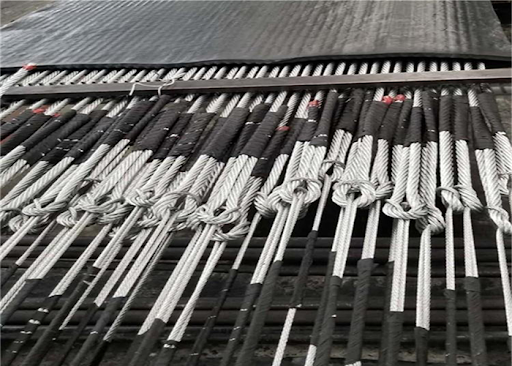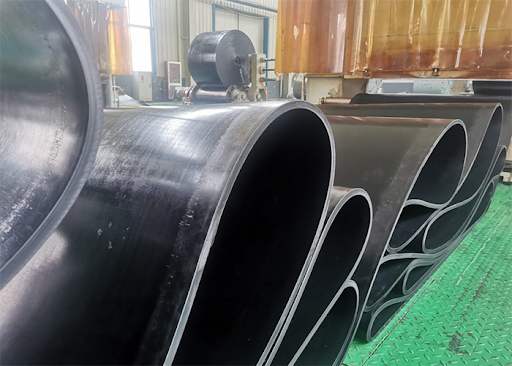To sign up for our daily email newsletter, CLICK HERE
Conveyor belts are integral to the mining industry, playing a critical role in the efficient and continuous transport of materials from extraction points to processing locations or transport systems. These belts help in moving a vast range of materials, including ores and minerals, over varying distances and terrains. The types of Mining conveyor belt are designed to meet specific operational demands and can vary significantly. They range from steel cord belts known for their durability and strength, ideal for long-distance transport, to nylon belts valued for their flexibility and resistance to harsh environmental conditions. Understanding these varieties is crucial for selecting the right conveyor belt that aligns with the operational and environmental challenges of a mining project.

Detailed Analysis of Steel Cord Conveyor Belts
Steel cord conveyor belts represent a significant advancement in conveyor technology and are designed to meet the demands of modern industrial operations, particularly in mining. This section delves into the structure and composition of steel cord conveyor belts and their specific applications in mining for transporting heavy materials.
Structure and Composition
Steel cord conveyor belts are constructed from high tensile strength steel cords that are aligned in a longitudinal direction and are embedded in a rubber matrix. The basic structure can be detailed as follows:
Steel Cords: The core of the belt consists of several steel cords made from high-grade steel. These cords are arranged in a specific pattern to provide maximum strength and flexibility. The number of steel cords and their diameter can vary depending on the belt’s design and the load requirements of the application. These cords are designed to handle tensile forces and prevent elongation of the belt under heavy loads.
Top Cover: The top cover of the belt is made of rubber or a rubber-based composite material that is designed to protect the internal steel cords from abrasion, impacts, and other damaging factors. This layer is typically thicker in belts used for harsher conditions, such as those found in mining operations.
Bottom Cover: Similar to the top cover, the bottom cover acts as a protective layer for the underside of the belt. It is made from the same material as the top cover and serves to prevent wear and tear from the conveyor structure itself.
Adhesion Layer: Between the steel cords and the rubber covers, there is an adhesion layer that helps in binding the steel cords with the rubber, ensuring that the mechanical strength is transferred efficiently from the cords to the belt.
Edge Rubber: The edges of steel cord conveyor belts are often sealed with a special rubber to prevent ingress of moisture or particles that could corrode or damage the steel cords.

Applications in Mining for Transporting Heavy Materials
Steel cord conveyor belts are particularly advantageous in the mining industry due to their ability to transport heavy and abrasive materials across long distances. Some of the key applications and benefits in this sector include:
High Tensile Strength for Heavy Loads: The high tensile strength of steel cord belts allows them to support heavier loads than fabric belts. This is crucial in mining operations where large quantities of ore or coal must be moved efficiently from the mine to processing facilities or transport terminals.
Low Elongation: One of the significant advantages of steel cord belts is their low elongation, which is particularly important in long conveyor runs common in open pit or deep mine operations. This characteristic ensures that the belt maintains its length under load, reducing the need for frequent re-tensioning and maintenance.
Durability in Harsh Environments: The robust construction of steel cord belts makes them ideal for the abrasive and often corrosive environments found in mining. The rubber covers are designed to resist cuts, abrasions, and impacts, thereby prolonging the life of the belt.
Energy Efficiency: Despite their strength, steel cord belts offer good flexibility, which reduces the energy required to start and operate the conveyor system. This efficiency is crucial in reducing the overall operational costs in mining operations.
Safety and Reliability: The reliability of steel cord conveyor belts contributes to safer mining operations. Their ability to perform under extreme conditions reduces the risk of belt failure, which can lead to operational delays or hazardous situations.
The detailed structure and robust composition of steel cord conveyor belts make them ideally suited for heavy-duty applications in mining. Their ability to handle significant loads, resist environmental challenges, and provide reliable and efficient service underpins their preference in the mining sector, where operational efficiency and safety are paramount.
Insight into Nylon Conveyor Belts
Composition and Design
Nylon conveyor belts are crafted from synthetic polyamide fibers, which are known for their high strength and elasticity. The design typically incorporates multiple layers of nylon fabric coated with rubber, which enhances durability and provides necessary traction. This structure is pivotal for achieving the optimal balance of flexibility and strength, allowing the belts to handle the mechanical demands of mining operations effectively.
Ideal Scenarios for Their Use in Mining Operations
Nylon conveyor belts are particularly suited for scenarios where the conveyor path may involve curves and changes in elevation. Their high impact resistance and excellent shock absorption properties make them ideal for transporting materials that may cause significant wear and tear, such as crushed rock and other abrasive substances. These belts perform well in environments where varying temperature and moisture levels are a concern, maintaining their integrity and operational efficiency under challenging conditions.

Comparative Analysis
In this section, we conduct a detailed comparative analysis of steel cord and nylon conveyor belts, two prominent types used across various industrial applications. The comparison will focus on key attributes such as load capacity, durability, and cost-effectiveness, which are critical factors in the decision-making process for selecting the right conveyor belt.
Direct Comparison of Steel Cord and Nylon Conveyor Belts
Material and Construction:
Steel Cord Belts: These belts are constructed with steel cords that run longitudinally and are embedded in a matrix of high-quality rubber. The steel cords are the primary load-bearing element, providing high tensile strength.
Nylon Belts: Nylon belts, on the other hand, are made from fabric that consists of nylon fibers. These fibers are woven in a manner that allows the belt to absorb impact and maintain flexibility.
Load Capacity:
Steel Cord Belts: They excel in load capacity due to the inherent strength of the steel cords. These belts are capable of handling extremely high loads over long distances with minimal elongation, making them ideal for heavy-duty applications in industries like mining and quarrying.
Nylon Belts: While nylon belts are strong, they typically do not match the load capacity of steel cord belts. They are more suitable for medium-duty applications where high tensile strength is not as critical.
Durability:
Steel Cord Belts: These belts offer superior durability under harsh conditions. The steel cords provide excellent resistance to stretching and breaking under strain, while the rubber matrix protects against abrasions, impacts, and environmental factors like moisture and chemicals.
Nylon Belts: Nylon belts are generally less durable under extreme conditions. They are more susceptible to wear and tear from abrasive materials and can degrade under exposure to certain chemicals or variable temperature conditions.
Cost-Effectiveness:
Steel Cord Belts: Initially, steel cord belts are more expensive due to their complex manufacturing process and high-quality materials. However, their longevity and lower maintenance needs can make them more cost-effective over time, particularly in applications involving heavy loads and harsh environments.
Nylon Belts: Nylon belts are less expensive initially and might be cost-effective for applications with lower requirements for load capacity and durability. They are also easier to install and maintain, which can reduce upfront costs.
Discussion on Load Capacity, Durability, and Cost-Effectiveness
Load Capacity:
Steel cord belts are unmatched in their ability to support heavy loads over long conveyor systems with minimal elongation, which is a critical factor in industries such as mining where the conveyor distances are vast.
Nylon belts provide sufficient load capacity for many general-purpose applications and are preferable in situations where flexibility is more important than maximum strength.
Durability:
Steel cord belts are designed to withstand severe operational stresses, making them a preferred choice in environments that involve heavy impacts, sharp materials, or extreme conditions.
Nylon belts offer good resistance to impacts and are suitable for applications where conditions are controlled or less severe.
Cost-Effectiveness:
Steel cord belts often represent a higher initial investment but offer greater returns over time due to their extended lifespan and reduced maintenance needs in demanding applications.
Nylon belts might offer cost savings upfront and are adequate for less intensive applications, but may incur higher maintenance and replacement costs in tougher conditions.
The choice between steel cord and nylon conveyor belts should be guided by the specific needs of the application, considering factors like load capacity, durability, and overall cost-effectiveness. While steel cord belts are ideal for heavy-duty applications, nylon belts can be perfectly suitable for less demanding conditions where flexibility and lower initial costs are prioritized.
Case Studies
Real-world Applications of Both Types of Belts in Mining
In the mining sector, steel cord and nylon conveyor belts have demonstrated their value in various scenarios. Steel cord belts are often utilized in large-scale mining operations that require belts to cover significant distances with minimal elongation. For instance, in iron ore mining, steel cord belts facilitate the transportation of materials from deep pits to processing plants over kilometers. On the other hand, nylon belts are frequently used in smaller, more complex mining setups where adaptability and resistance to varying environmental conditions are necessary, such as in coal mining where the belts may need to navigate tight spaces and sharp elevations.
Lessons Learned and Best Practices
Case studies have highlighted the importance of regular maintenance and monitoring for maximizing the lifespan and efficiency of both types of belts. For steel cord belts, attention to proper alignment and tensioning is crucial to prevent premature wear and failures. For nylon belts, ensuring that the belt is well-suited to the specific environmental conditions, such as moisture and temperature variations, is key. Best practices also include choosing a belt with the appropriate specifications for the expected load and wear conditions, and investing in quality splicing and repair services to maintain optimal performance.